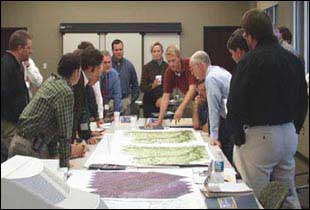















Successes in Stewardship: April 2005 |
|---|

|
Federal Highway Administration
April 2005
South Carolina's Interstate 73 Interagency Partnership

Considered by many to be the most significant new road construction project in the State, South Carolina's segment of Interstate 73 (I-73) is expected to support economic development and to improve hurricane evacuation. Moreover, Congress has designated I-73, which as planned will run between Detroit, Michigan and the Myrtle Beach/Grand Strand area of South Carolina, as a high-priority corridor. I-73 would improve mobility and support economic growth by linking the Myrtle Beach area to I-95.
The tourist and year-round populations of the Myrtle Beach area are growing. Each year, more than 80 percent of the area's 13 million tourists use the State's road system. As a controlled access facility, I-73 would be designed to allow reversing southbound lanes for relieved congestion and greater traffic mobilization during an emergency evacuation. For these reasons, in August of 2004, the Federal Highway Administration (FWHA) filed a Notice of Intent, formally beginning the process to develop an Environmental Impact Statement (EIS) for the project. The EIS covers a southern segment of the study area, extending from Myrtle Beach north approximately 60 miles to Interstate 95 (I-95). Environmental review for a northern segment of the highway that would connect I-95 to I-73 near Rockingham, North Carolina is planned for a later date.

|
With a project of such magnitude, FHWA and the South Carolina Department of Transportation (SCDOT) were looking for ways to streamline the environmental review process. Previously in South Carolina, agencies were sometimes not involved early in the transportation decisionmaking process, leading to miscommunication. Seeking to avoid similar impediments, SCDOT, in conjunction with FHWA, undertook for this project, a collaborative effort with resource agencies that was unprecedented in the State. This effort, called the I-73 Interagency Partnership, is a multi-year initiative intended to help SCDOT further its environmental streamlining and stewardship goals.
The I-73 Partnership is comprised of 12 Federal and State agencies. Each agency has agreed to a series of strategically planned interagency workshops. These meetings, facilitated by an outside contractor, bring resource and regulatory agencies to the transportation-decisionmaking table, ensuring that all interests are incorporated throughout the project. By getting the right people involved in the National Environmental Policy Act (NEPA) process early and continuously, the project team anticipates better and more readily implemented decisions for I-73.
The I-73 Partnership is advancing environmental streamlining and stewardship in several ways. Primarily, the involved agencies are working to ensure that the NEPA process and the project's permitting process occur concurrently. This is the first time that any project in South Carolina has been developed this way. By obtaining necessary permits in conjunction with the NEPA process, SCDOT is helping to secure two keys to success: agency buy-in throughout the process and a shorter time horizon for project completion.
Other specific streamlining aspects of the Partnership include:
|
A Partnership for Permitting: Washington State's Multi-Agency Permitting Team (MAP Team)
Like SCDOT, Washington Department of Transportation (WSDOT) is exploring new ways to partner with other agencies. In November of 2003, three Washington State agencies and one Federal agency joined forces in a new approach to permitting — the Multi-Agency Permitting Team (MAP Team). In 2004, the King County Department of Development and Environmental Services joined the effort. The MAP Team has one primary goal — to make permit decisions for a selected set of WSDOT projects. The MAP Team helps create an accountable, transparent process that is able to identify risks and opportunities, and address and avoid conflicts early, thereby achieving permit decisions in a predictable and timely manner. This process can reduce environmental impacts and help keep projects on schedule. More information. |
SCDOT applied well-planned actions to ensure that the I-73 Partnership started with a strong foundation and grew to provide long-lasting benefits.
Contact InformationMr. Patrick TyndallFederal Highway Administration South Carolina Division 1835 Assembly Street, Suite 1270 Columbia, SC 29201-2483 Phone: (803) 765-5194 |
|
|
